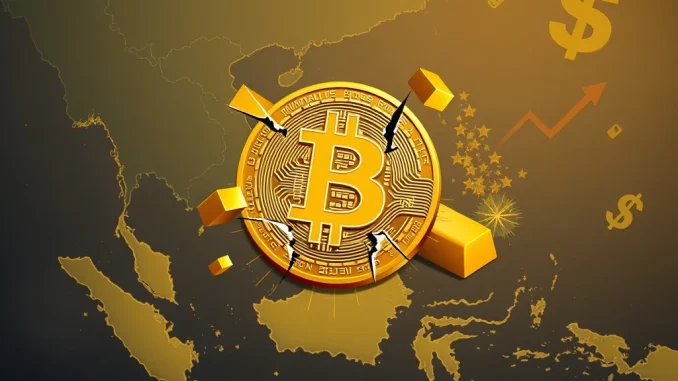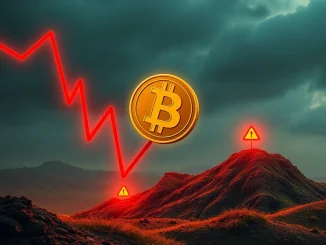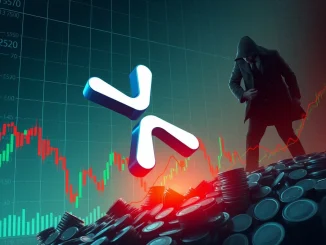
The cryptocurrency world is abuzz with concern as Bitcoin price recently plummeted below the crucial $115,000 mark. This significant dip isn’t just market noise; it’s a direct ripple effect from escalating geopolitical tensions, specifically the intensifying border conflict between Thailand and Cambodia. Investors are seeking refuge, but perhaps not where you’d expect in the digital asset space.
Bitcoin Price Under Pressure: Geopolitical Tremors Shake the Market
On July 25, the deployment of F-16 fighter jets by Thailand against Cambodian border positions, coupled with Cambodia’s appeal to the United Nations, sent shockwaves through global markets. The immediate concern centered on Southeast Asia’s supply chain stability, triggering a widespread risk-off sentiment across Asian equities. Capital rapidly shifted towards traditional safe-haven assets like gold and the U.S. dollar, as investors prioritized stability over risk. Concurrently, the cryptocurrency market experienced significant outflows, with Bitcoin price notably breaching the critical $115,000 support level. This threshold was previously considered a key psychological barrier, and its collapse signals a deeper market anxiety.
The Shifting Landscape of Safe-Haven Assets
Historically, in times of global uncertainty, investors flock to assets perceived as ‘safe havens.’ Gold, with its long-standing reputation as a store of value, and the U.S. dollar, backed by the world’s largest economy, typically see increased demand. This recent conflict has reinforced this traditional behavior. While Bitcoin has, at times, been touted as a ‘digital gold’ or a hedge against inflation and geopolitical instability, its reaction to the Thai-Cambodian conflict tells a different story. Instead of acting as a safe-haven asset, Bitcoin has mirrored the broader risk-asset sell-off, indicating that for many institutional and retail investors, it still behaves more like a growth stock than a defensive play during acute geopolitical risk events.
Understanding the Geopolitical Risk Impact on Crypto
The direct impact of geopolitical risk on the crypto market is multifaceted. Firstly, heightened global instability leads to a general reduction in risk appetite. Investors, facing uncertainty, often liquidate their more volatile holdings to secure capital. Cryptocurrencies, despite their growing mainstream adoption, are still largely perceived as high-risk, high-reward investments. Secondly, major geopolitical events can trigger liquidity crunches in certain regions, forcing investors to sell assets to meet margin calls or simply to free up cash. The current situation in Southeast Asia, with its potential to disrupt global supply chains, amplifies these concerns, making the crypto market particularly vulnerable to sudden shifts in investor sentiment.
Navigating the Current Crypto Market Volatility
The breakdown in Bitcoin price action below $115,000 reflects broader market anxieties. This zone had historically absorbed selling pressure, but its recent collapse suggests diminished confidence in near-term stability. Analysts at Bitunix highlighted that the $120,000–$121,500 range remains a critical resistance wall, where prior liquidation activity was concentrated. A failure to reclaim $115,000 could exacerbate downward momentum, potentially driving BTC toward $112,300, according to their forecast.
Strategic recommendations from Bitunix emphasize caution. The firm advises:
- Monitoring Geopolitical Developments: Pay close attention to how markets react to further military or diplomatic developments in Southeast Asia.
- Volume Validation: Any rebound attempt in Bitcoin’s price must demonstrate sufficient buying volume to counter bearish pressure.
- VIX Index Tracking: If the VIX volatility index (a proxy for market fear) continues rising, risk-off selling could persist.
- Strict Controls: Maintain strict leverage and exposure controls to manage potential losses in a highly volatile environment within the crypto market.
Key BTC Support Levels to Watch
For traders and investors, understanding key technical levels is crucial during volatile periods. The $115,000 mark is no longer just a psychological barrier; it has now flipped from a support to a resistance level. Reclaiming this level with conviction, supported by significant buying volume, would be a strong bullish signal. However, if Bitcoin price fails to recover and consolidate above $115,000, the next significant BTC support level to watch is around $112,300, as identified by analysts. A breach of this level could signal further declines, potentially testing lower liquidity zones. Conversely, a successful defense of $112,300 followed by a move back above $115,000 could indicate a potential short-term bottom and a re-evaluation of market sentiment.
The interplay between geopolitical shocks and asset prices underscores the fragility of current market conditions. While traditional safe-haven assets like gold and the dollar have gained traction, cryptocurrencies remain vulnerable to sudden shifts in investor sentiment. The crypto market’s performance will likely hinge on broader macroeconomic indicators, including central bank responses and regional de-escalation efforts. For now, traders are advised to adopt a wait-and-see approach, prioritizing defensive strategies until clearer signals emerge. The current situation serves as a stark reminder that even in the digital age, real-world events can have profound and immediate impacts on our portfolios.
Frequently Asked Questions (FAQs)
Q1: Why did Bitcoin’s price drop despite being called “digital gold” by some?
A1: While Bitcoin has been dubbed “digital gold,” its recent price action during the Thai-Cambodian conflict shows it’s currently behaving more like a risk-on asset. Investors are liquidating volatile holdings and moving capital into traditional safe havens like physical gold and the U.S. dollar, indicating that Bitcoin is not yet universally seen as a primary safe-haven during acute geopolitical crises.
Q2: What is the significance of the $115,000 support level for Bitcoin?
A2: The $115,000 level was a critical psychological and technical support barrier for Bitcoin. Its breach suggests diminished investor confidence and increased selling pressure. This level has now flipped to a resistance, meaning Bitcoin would need strong buying volume to reclaim and hold above it to signal a potential recovery.
Q3: How do geopolitical conflicts affect the cryptocurrency market?
A3: Geopolitical conflicts typically lead to increased market uncertainty and a general “risk-off” sentiment. Investors tend to sell volatile assets, including cryptocurrencies, to secure capital. Such events can also trigger liquidity crunches and shift investor focus away from speculative assets towards more stable, traditional safe havens.
Q4: What are “safe-haven assets” and why are they gaining traction now?
A4: Safe-haven assets are investments that are expected to retain or increase in value during times of market turbulence or economic uncertainty. Gold and the U.S. dollar are classic examples. They are gaining traction now because the escalating Thai-Cambodian conflict has heightened geopolitical risk, prompting investors to seek stability and preserve capital.
Q5: What should investors do during this period of volatility?
A5: Analysts recommend a cautious “wait-and-see” approach. Prioritize defensive strategies, monitor the geopolitical situation closely, and pay attention to market sentiment indicators like the VIX index. It’s advisable to manage leverage and exposure strictly and ensure any rebound attempts are backed by significant trading volume before making aggressive moves.



